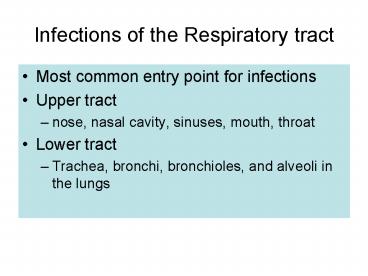Infections of the Respiratory tract PowerPoint PPT Presentation
1 / 16
Title: Infections of the Respiratory tract
1
Infections of the Respiratory tract
- Most common entry point for infections
- Upper tract
- nose, nasal cavity, sinuses, mouth, throat
- Lower tract
- Trachea, bronchi, bronchioles, and alveoli in the
lungs
2
Fig. 21.1a
3
Protective Mechanisms
- Normal flora Commensal organisms
- Limited to the upper tract
- Mostly Gram positive or anaeorbic
- Microbial antagonist (competition)
4
Protective Mechanisms
Clearance of particles and organisms from the
respiratory tract
Cilia and microvilli move particles up to the
throat ? where they are swallowed. Alveolar
macrophages migrate and engulf particles and
bacteria in the alveoli.
5
Other Protective Mechanisms
- Nasal hair, nasal turbinates
- Mucus
- Involuntary responses (coughing, etc.)
- Immune cells
- sIgA
6
Upper respiratory tract
- Rhinitis Common cold
- Common Cold virus over 100 serotypes
- Sinusitis
- Miscellaneous comensual bacteria
- Pharyngitis
- Group A Strep - Streptoccus pyogenes
- Many viruses
- Diphtheria - Corynebacterium diphtheriae
7
Pharyngitis
- Group A Strep
- Primary Pharyngitis
- ?
- Secondarily
- Scarlet fever erythrogenic toxin
- Rheumatic fever Heart damage
- Glomerulonephritis Kidney damage
8
Upper and lower respiratory tract
- Whooping cough Bordetella pertusis
- Respiratory syncytial virus (RSV)
- Influenza virus
9
- Influenza Virus
- New human strains every year
- Mutations
- Pandemic strains ?
- Genetic Recombinant Viruses 1957 Asian Flu
H2N2 - 1968 Hong Kong Flu H3N2
- 1977 Russian Flu H1N1
- Bird Flu
- Directly from birds
- ?? H5N1
10
H and N Flu Glycoproteins
- H Hemagglutinin ?
- Specific residues bind to host cells of
- the respiratory mucosa
- Different residues are recognized by
- the host antibodies
- Residues are subject to changes
- N - Neuraminidase
- Breaks down protective
- mucous coating
- Assist in viral release
11
Lower respiratory tract
- Tuberculosis
- Pneumonia
- Viral, bacterial
- And fungal agents
12
Tuberculosis
- Bacterial infection
- Mycobacterium tuberculosis
A tubercle in the lung is a granuloma consisting
of a central core of TB bacteria inside an
enlarged macrophage, and an outer wall of
fibroblasts, lymphocytes, and neutrophils.
13
Tuberculosis
- Primary
- Lung tubercles, caseous, tuberculin skin reaction
- Secondary (reactivation)
- Consumption Coughing and chronic weight loss
- Dissemination
- Extrapulmonary TB (lymph nodes, kidneys, bones,
genital tract, brain, meninges)
14
Pneumonia
- Bacterial, viral or fungal infection
- Inflammation of the lung with fluid filled alveoli
15
Bacterial Pneumonia
- Streptococcus pneumoniae
- 2/3 of all pneumonia
- High risk - old age, season, underlying
- viral infection, diabetes, alcohol and narcotic
use - Variable capsular antigen
- Vaccines
- Mycoplasma pneumoniae
- Legionella pneumophila
16
Mycoplasma pneumoniae
- Smallest known bacteria
- No cell wall
- Walking pneumonia atypical pneumonia
Legionella pneumophila
- Less common but still a serious infection
- Survives in natural habitat (tap water, cooling
- towers, spas, etc.)
- Opportunistic disease

